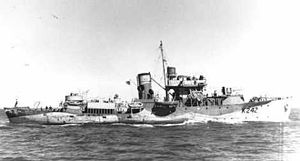HMCS Ville de Quebec (K242)
 HMCS Ville de Québec
| |
| History | |
|---|---|
| Name | Ville de Québec |
| Namesake | Quebec City, Quebec |
| Builder | Morton Engineering and Dry Dock Co. , Quebec City |
| Laid down | 7 June 1941 |
| Launched | 12 November 1941 |
| Commissioned | 24 May 1942 |
| Decommissioned | 6 July 1945 |
| Identification | Pennant number: K242 |
| Honours and awards | Atlantic 1942–1944, Mediterranean 1943, English Channel 1944–1945;[1] Gulf of St. Lawrence[2] |
| Fate | Sold for mercantile use |
| General characteristics | |
| Class and type | Flower-class corvette (Revised) |
| Displacement | 925 long tons (940 t; 1,036 short tons) |
| Length | 205 ft (62.48 m)o/a |
| Beam | 33 ft (10.06 m) |
| Draught | 11.5 ft (3.51 m) |
| Propulsion |
|
| Speed | 16 knots (29.6 km/h) |
| Range | 3,500 nautical miles (6,482 km) at 12 knots (22.2 km/h) |
| Complement | 85 |
| Sensors and processing systems |
|
| Armament |
|
HMCS Ville de Québec was a
Background
Flower-class corvettes like Ville de Québec serving with the Royal Canadian Navy during the Second World War were different from earlier and more traditional sail-driven corvettes.
Corvettes commissioned by the Royal Canadian Navy during the Second World War were named after communities for the most part, to better represent the people who took part in building them. This idea was put forth by Admiral Percy W. Nelles. Sponsors were commonly associated with the community for which the ship was named. Royal Navy corvettes were designed as open sea escorts, while Canadian corvettes were developed for coastal auxiliary roles which was exemplified by their minesweeping gear. Eventually the Canadian corvettes would be modified to allow them to perform better on the open seas.[9]
Construction
Ville de Québec was ordered as part of the Revised 1940–41 Flower-class building program. This revised program radically changed the look of the Flower-class corvette. The ships of this program kept the water-tube boilers of the initial 1940–41 program, but now they were housed in separate compartments for safety. The
Ville de Québec was laid down by
Service history
Ville de Québec arrived at Halifax 12 June 1942. After workups she was assigned to the Western Local Escort Force (WLEF) in late July 1942. During this period with WLEF she was used almost exclusively on Boston – Halifax convoys.[11]
In September 1942, Ville de Québec was allocated for Operation Torch, the Allied invasion of North Africa. On 28 October 1942, while crossing to the United Kingdom she and HMCS Alberni picked up 81 survivors from the British whale factory ship Sourabaya that was torpedoed and sunk the previous day in the North Atlantic.[10] She arrived at Derry on 10 November and spent the next four months escorting convoys between the United Kingdom and Gibraltar.[11] While on escort duty she sank the U-224 in the western Mediterranean Sea west of Algiers by ramming and depth charges.[10]
Ville de Québec returned to Canada in April 1943 and joined Quebec Force on 12 May, escorting convoys between Quebec and Sydney. In late September she rejoined WLEF as part of escort group W-2. She remained with them until mid January 1944 when she departed for refit.[11]
After working up in
Ville de Québec was
Notes
- ^ "Battle Honours". Britain's Navy. Retrieved 6 September 2013.
- ^ "Royal Canadian Warships – The Battle of the Gulf of St. Lawrence – Second World War". Veterans Affairs Canada. Retrieved 6 September 2013.
- ^ Ossian, Robert. "Complete List of Sailing Vessels". The Pirate King. Retrieved 13 April 2011.
- ^ Fitzsimons, Bernard, ed. (1978). The Illustrated Encyclopedia of 20th Century Weapons & Warfare. Vol. 11. London: Phoebus. pp. 1137–1142.
- ISBN 0-517-67963-9.
- ISBN 0-8117-3275-4.
- ISBN 0-87021-913-8.
- ISBN 0-87021-450-0.
- ^ ISBN 1-55125-052-7.
- ^ a b c d "HMCS Ville de Quebec (K 242)". Uboat.net. Retrieved 6 September 2013.
- ^ ISBN 0-00216-856-1.
- ^ "Quebec (6114008)". Miramar Ship Index. Retrieved 14 July 2016.
External links
- Hazegray. "Flower Class". Canadian Navy of Yesterday and Today. Retrieved 6 September 2013.
- Ready, Aye, Ready. "HMCS Ville de Quebec (1st)". Retrieved 6 September 2013.
{{cite web}}: CS1 maint: multiple names: authors list (link)
